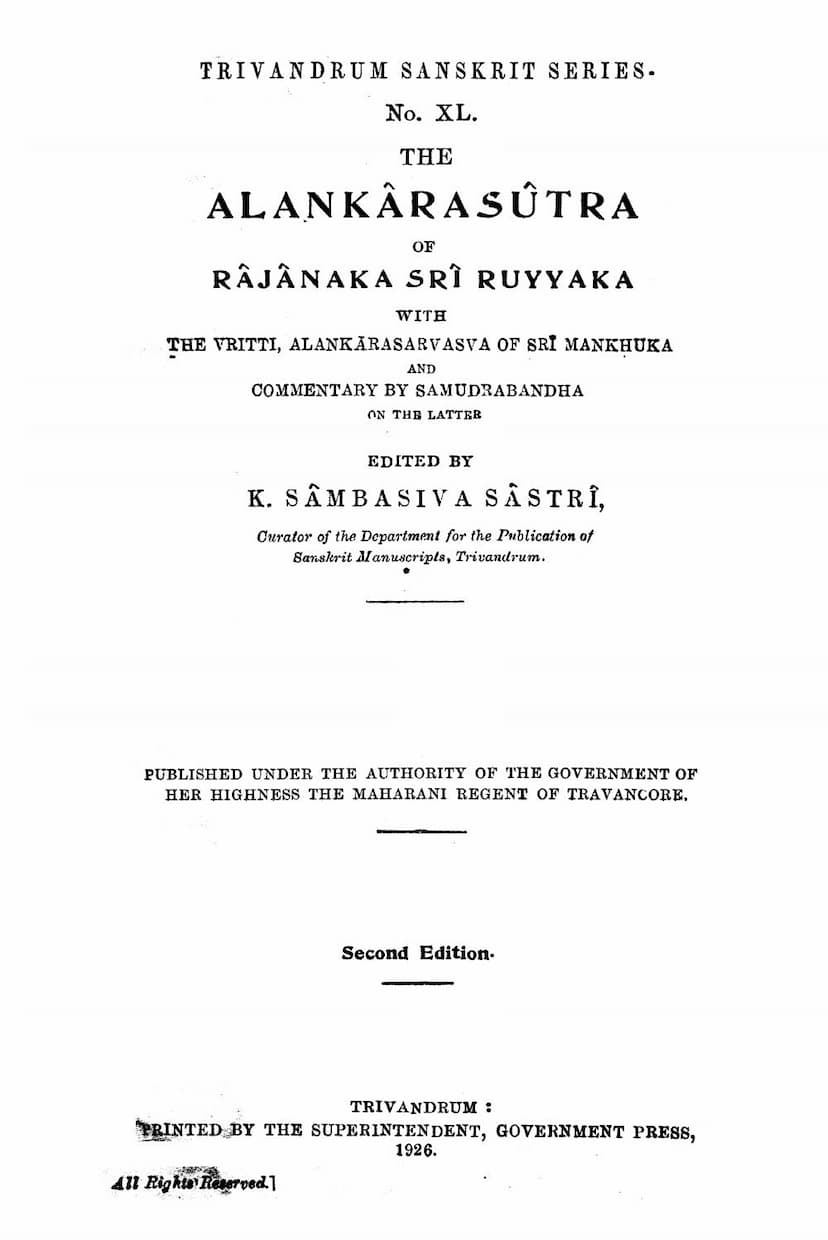Alankar Sutra
Added to library: September 1, 2025

Summary
Here's a comprehensive summary of the Jain text "Alankar Sutra" by K. Sambashiva Sastri, based on the provided pages:
The book is the second edition of the Alankarasutra of Rajanaka Sri Ruyyaka. It also includes:
- The Vritti (commentary) called Alankarasarvasva of Sri Mankhuka.
- A commentary by Samudrabandha on the Alankarasarvasva.
This publication is the 40th number of the Trivandrum Sanskrit Series and was published under the authority of the Government of Her Highness the Maharani Regent of Travancore in 1926.
Authorship and Textual History:
- The preface delves into a scholarly debate regarding the authorship of Alankarasarvasva. While it was long believed that Ruyyaka authored both the sutras and the vritti, the evidence presented suggests a different scenario.
- The editor notes that Mankhuka, in his Srikanthacharita, refers to Ruyyaka as his preceptor (guru).
- The introductory stanza of the present work states, "गुर्वलङ्कारसूत्राणां वृत्त्या तात्पर्यमुच्यते" (The meaning of the Alankarasutras of the preceptor is explained in the Vritti), further supporting Ruyyaka as the sutra author and Mankhuka as the vritti author.
- The concluding stanza of the work by Mankhuka explicitly names him as the author of Alankarasarvasva: "इति मङ्खुको वितेने काश्मीरक्षितिपसान्धिविमहिकः । सुकविमुखालङ्करणं तदिदमलङ्कारसर्वस्वम् ॥"
- The commentator, Samudrabandha, also identifies Mankhuka as the author of Alankarasarvasva and uses the reading "गुरू" in the introductory line, indicating his view that the sutra author was Mankhuka's preceptor.
- Samudrabandha's commentary occasionally explains the sutra portion as well, implying he considered both sutra and vritti as part of a single concept called Alankarasarvasva, with Mankhuka as the author.
- The preface acknowledges that conclusive opinions on authorship require further evidence from the many works of Ruyyaka and Mankhuka.
Content and Significance:
- The work is described as a third Alankarasutra, distinct from those of Vamanacharya (Kavyalankarasutra) and the Buddhist monk Buddhodanimuni (Alankarayidyasutra).
- The Alankarasarvasva, as presented in this edition, is highly regarded for its elucidation of Arthālankâras (semantic figures of speech), surpassing even Mammata's Kavyaprakasa in this regard and offering criticisms of some of Mammata's views.
- The commentary by Samudrabandha is considered superior to Jayaratha's commentary published in the Kavyamala series.
- The work has been highly esteemed by scholars, with Sahityachakravarti Louhitya Bhattagopala quoting its views as decisive in his commentary on Kavyaprakasa.
- The publication includes an index for quotations, which was not present in the first edition.
Key Figures Mentioned:
- Rajanaka Sri Ruyyaka: Author of the Alankarasutra.
- Sri Mankhuka: Author of the Vritti (Alankarasarvasva).
- Samudrabandha: Commentator on the Alankarasarvasva.
- Vidyachakravartin: Refers to Alankarasarvasva as Ruyyaka's work.
- Ravi Varma Bhupa (Sangramadhira): The king of Kolamba (Quilon) whose court was adorned by Samudrabandha.
- Simharaja: Possible father of Samudrabandha, author of Prakrita-Rupavatara.
- Mammata Bhatta: Author of Kavyaprakasa, whose views are discussed and criticized.
- Udbhata, Vamana, Bhattanayaka, Anandavardhana, Bhatta Bhatta, Rudrata, Bhoja: Mentioned as influential figures in the field of poetics (Alankara).
Textual Details:
- The edition is based on palm-leaf manuscripts written in Malayalam script.
- The book's structure includes the Alankarasutra, the Vritti (Alankarasarvasva), and the Commentary (by Samudrabandha).
- A Table of Contents (विषयानुक्रमः) lists 82 categories of Alankaras (figures of speech).
In essence, this work is a significant scholarly edition of a foundational text on Indian poetics (Alankara Shastra), meticulously edited and presented with valuable historical and critical context regarding its authorship and development.